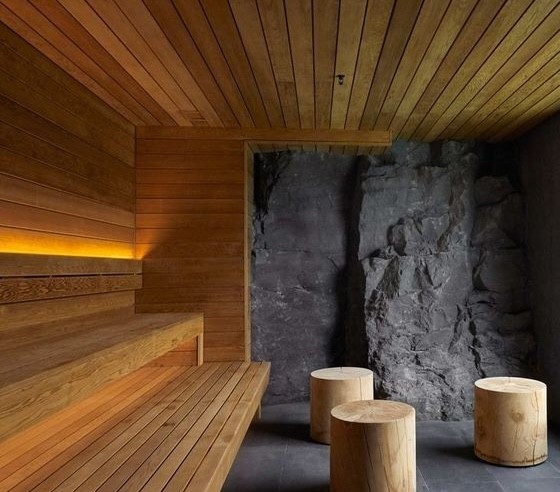Sauna Design

SAUNA DESIGN
Saunas are spaces designed for relaxation and detoxification, combining therapeutic heat and humidity. When designing a sauna, it’s important to consider factors such as functionality, aesthetics, and comfort. At Bahçeşehir Decoration and Architecture, we focus on creating saunas that provide a harmonious and peaceful atmosphere, while ensuring they are practical and effective in their purpose.
KEY FACTORS TO CONSIDER IN SAUNA DESIGN
-
Space and Layout
The size and layout of the sauna are the first considerations. Saunas should be spacious enough for users to relax comfortably. Depending on the type of sauna (traditional Finnish sauna, infrared sauna, steam room, etc.), the layout and the type of heating system will vary. A traditional sauna requires a dry, enclosed space, while a steam room needs a more humid, enclosed environment. -
Materials
The choice of materials is crucial for both the sauna's aesthetics and its functionality. Common materials used in sauna construction include natural wood, stone, and tile. Wood, such as cedar or pine, is a popular choice because it has a pleasant aroma and resists heat well. The wood should be treated to withstand high temperatures and humidity without warping or deteriorating.Stones are often used in the sauna's stove or heater, providing additional heat retention. In steam rooms, ceramic or natural stone tiles are often preferred due to their moisture resistance and easy maintenance.
-
Lighting
Proper lighting creates a serene atmosphere. Soft, warm lighting is ideal for saunas. Hidden lighting, such as LED strips behind wood panels or stone walls, can create a calming ambiance. It is essential that the lighting is heat-resistant and does not interfere with the sauna’s functionality. -
Ventilation
Good ventilation is essential in sauna design to ensure fresh air circulation and to prevent excessive humidity buildup. The design should include ventilation systems that can be adjusted according to the heat levels and humidity in the room. -
Temperature and Humidity Control
Temperature is one of the most important aspects of a sauna's functionality. A good sauna should allow the user to adjust the temperature to their personal preferences. Traditional saunas are often heated using a wood-burning stove or electric heater, and the temperature can range from 70°C to 100°C (158°F to 212°F). Humidity levels can also vary, and some saunas have humidity controls to maintain an ideal balance. -
Seating Arrangement
Comfortable seating is a critical element in sauna design. Benches should be made from heat-resistant materials and should be designed to allow users to sit or lie comfortably. The seating arrangement should be planned to allow for adequate space for movement and relaxation, while maintaining a sense of intimacy and privacy. -
Aesthetic Considerations
The overall aesthetic of the sauna should align with the rest of the design elements in the space. A modern sauna may feature sleek, minimalistic designs with clean lines, glass panels, and light wood finishes. On the other hand, a more traditional sauna may incorporate rustic elements like dark wood, stone, and metal features.
DESIGNING A TRADITIONAL FINNISH SAUNA
The Finnish sauna is one of the most popular types, known for its dry heat and high temperatures. Key elements to consider in designing a traditional Finnish sauna include:
- Wood: Finnish saunas are typically built with softwood, such as spruce or pine, which provide a pleasant aroma and are able to withstand heat. The wood should be treated to resist moisture and temperature changes.
- Stove: A wood-burning or electric stove is used to heat the sauna. The stove should be placed in a corner or along the wall to allow for maximum heat circulation.
- Benches: The benches are usually arranged on multiple levels, with the highest bench being the warmest. The seating should be spacious, allowing for comfortable reclining.
DESIGNING AN INFRARED SAUNA
Infrared saunas use infrared heaters to emit light that is absorbed by the skin, providing a more direct and efficient form of heat. When designing an infrared sauna:
- Infrared Panels: These should be strategically placed to ensure even heat distribution across the body. Infrared saunas typically require less space than traditional saunas.
- Seating: Benches are usually lower and can be made from materials that resist heat and reflect infrared light.
- Materials: Materials like cedar and hemlock are often used for their ability to withstand heat while creating a pleasant aesthetic.
DESIGNING A STEAM ROOM
Steam rooms use moist heat to provide therapeutic benefits. The design of a steam room focuses on controlling humidity levels and ensuring comfort.
- Humidity Control: The room must be completely sealed to prevent steam from escaping, and it should be equipped with a high-quality steam generator.
- Seating: The seating arrangement is similar to that of a traditional sauna but may include slanted seats to accommodate reclining positions.
- Tile or Stone: Ceramic or stone tiles are preferred for their ability to resist moisture. The materials should be non-porous to avoid mold and mildew buildup.
ADDITIONAL CONSIDERATIONS FOR SAUNA DESIGN
- Shower Areas: It's often beneficial to have a shower area adjacent to the sauna for users to rinse off before or after their session.
- Sauna Doors: Sauna doors should be made of heat-resistant, clear glass to allow users to see inside while ensuring proper insulation. The door should open outward for safety and easy access.
- Sound System: Some sauna designs incorporate sound systems, allowing users to listen to relaxing music or sounds during their sessions.
At Bahçeşehir Decoration and Architecture, we offer custom sauna designs tailored to your specific needs and preferences. Whether you're looking for a traditional Finnish sauna, an infrared sauna, or a steam room, we ensure the design is functional, aesthetically pleasing, and comfortable, creating a perfect retreat for relaxation and rejuvenation.
